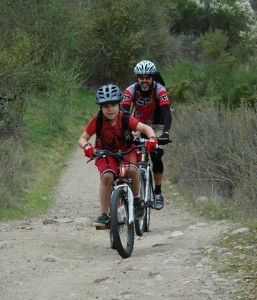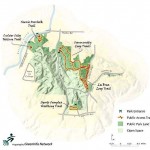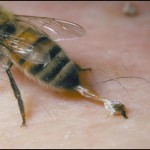From the Desert Sun (Palm Springs, CA)
Rattlesnakes are coming out of hibernation in the Coachella Valley about now.
![bilde[1]](http://corbamtb.com/news/wp-content/uploads/2010/03/bilde1-300x181.jpg)
A Western Diamondback Rattlesnake is indigenous to the Coachella Valley
The best way to deal with the slithering reptiles? Leave them alone.
“Rattlesnakes don’t look for trouble,” said Jim Cornett, a desert ecologist who lives in Palm Springs and has written three books about snakes. “They’re scared to death of us.”
At this time of year, valley residents are most likely to come across snakes on hiking trails.
“The best thing to do is give them a wide berth,” he said. “Stay about 10 feet away from them and walk around them.”
Snakes often stop when people approach and attempt to blend in with their surroundings to avoid detection.
If there’s not enough room on a trail to get around a snake, Cornett said hikers could either turn around or throw a handful of sand on the snake to let it know that it has been seen.
When snakes do bite people — usually on the hand, foot or ankle — Cornett said that in about a third of cases, the snake does not actually inject venom. But the only way to know is to get to a hospital.
“Any rattlesnake bite is a medical emergency,” he said. “You must go to the hospital.”
Venom helps rattlesnakes digest their prey.
“As the venom is inside the animal’s body, it starts to digest it even before the rattlesnake swallows it,” he said. “Unfortunately, in a human, it starts digesting your tissues.”
In a small percentage of cases where a snake bite has gone untreated for more than a couple hours, Cornett said the tissue damage has been so extensive that a finger, hand or arm has had to be amputated.
Officials from John F. Kennedy Memorial Hospital in Indio said the hospital keeps enough antivenin on hand to treat one snake bite patient. The valley’s three major hospitals share their antivenin supplies with each other as needed.
Cornett said that in March, snakes are most likely to be found near the rocky crevices and burrows where they’ve been hibernating since November.
“You’re more likely to see them in April than in March because they’re out and about, and generally they’re searching for a mate,” he said. “They are going to travel well beyond their little hibernation burrow, and there are records of rattlesnakes traveling several miles.”
The snakes stay out during the day until highs reach 85 or 90 degrees and nighttime temperatures stay above 70 degrees.
“By the end of April, rattlesnakes are primarily nocturnal,” he said. “That can happen a little bit earlier if it warms up rather quickly.”
Cornett said rattlesnakes often turn up in backyards at the edge of development, sometimes looking for rodents that may abound in the area or for cool, watered ground to lie on during warm days.
But he added that any snake found in the valley without a rattle on its tail is a nonvenomous species.
“If it’s a harmless snake and you live on the edge of a suburban area, I say count your blessings,” Cornett said.
That’s because two of the harmless species common to the valley can keep venomous rattlesnakes at bay.
“Whipsnakes (also commonly known as red racers) and kingsnakes will eat small rattlesnakes, and both those harmless snakes are immune to rattlesnake venom,” Cornett said.
![rattle-snake-coiled[1]](http://corbamtb.com/news/wp-content/uploads/2011/01/rattle-snake-coiled1.jpg) MRT is pleased to announce the 2011 Rattlesnake Avoidance Training Clinic For Dogs with Tracy Jenson-Presson of High on Kennels, San Diego County. Tracy has many years of experience training dogs to avoid rattlesnakes. She is well known for being a problem solver when it comes to difficult dogs. We have checked her out and you’re welcome to visit her website at: www.highonkennels.us
MRT is pleased to announce the 2011 Rattlesnake Avoidance Training Clinic For Dogs with Tracy Jenson-Presson of High on Kennels, San Diego County. Tracy has many years of experience training dogs to avoid rattlesnakes. She is well known for being a problem solver when it comes to difficult dogs. We have checked her out and you’re welcome to visit her website at: www.highonkennels.us






![bilde[1]](http://corbamtb.com/news/wp-content/uploads/2010/03/bilde1-300x181.jpg)

